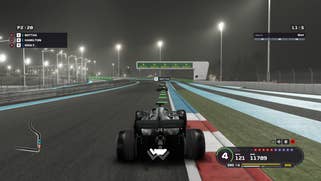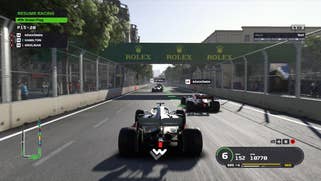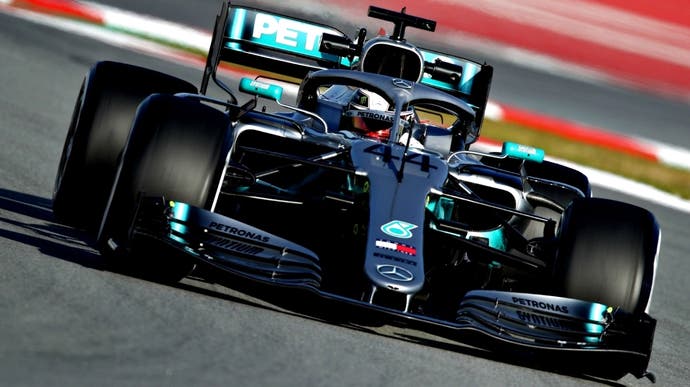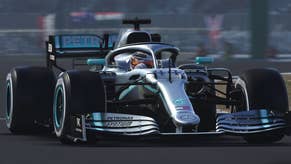F1 2019 delivers Codemasters' most realistic visuals yet
And here's how it scales across all PlayStation and Xbox consoles.
Is F1 2019 the most photo-realistic racing sim of its kind? Developer Codemasters has developed some gorgeous games this generation after all: Dirt Rally 2.0 is among the best in its field and later this year we'll see Grid rebooted on PS4 and Xbox One. But between those games, the F1 series is where we really see the team's EGO engine get an upgrade each year, iterated upon with every release. There's a sense of evolution rather than revolution then, but this latest F1 offering is definitely impressive.
While the graphical experience scales as you may expect across the console power ladder, it would be a disservice to Codemasters to call any version a disappointment visually. Each in their own way, every console is nicely optimised for. Loading up a race, whether that's Yas Marina with its gorgeous volumetric lights on lamps or the classic Spa circuit, the quality of materials translates to every system. A physically-based pipeline is at the heart of the EGO engine's achievements in Dirt 2.0, and it's very much in play here too. At first glance, the slick, dewy effect on tyres and the way rain splatters against car bodies creates an authentic, natural effect.
Lighting gets a big focus from Codemasters too, with a new volumetric system, marking a particular upgrade over 2018 which could look a little flat. This time, every roadside lamp and headlight casts proper beams of light outwards. Atmospheric effects like dust and dirt now fill in the air between too. It's the final piece in the puzzle in bringing the series up to par with the genre's best. Combined with the HDR implementation - which was already solid - it's genuine showcase material for modern living room displays.
There are some minus points that can't go overlooked. The camera motion blur is great but the team's use of temporal anti-aliasing returns, leaving a light banding trail. It only happens in select moments, and honestly for the majority of the duration, it's impossible to catch. However, up against fences, or anything with a high density of detail, you'll see some light artefacting as a result. That goes for any console, though PC does at least have the option to switch it off entirely.
There's also the goings-on outside the racing - the bits you'll most likely skip anyway as you try to get to the action. The engineering team are especially glaring and find themselves deep into the uncanny valley with their stiff, emotionless faces and rigid body motion capture. Perhaps it's a nitpick, especially after impressing so much with the core gameplay visuals. The on-track action is still standout, and ultimately, that's what counts.
So how does the multi-platform aspect play out? Perhaps unsurprisingly, Xbox One X takes point, with a 3840x2160 resolution supplied via what looks like some form of temporal reconstruction, given away by checkerboard-like artefacts in motion. Thankfully, they're not intrusive in the midst of a race, and with TAA and motion blur on the go, the moving picture blends it out of sight. Presentation-wise, the result perhaps isn't as crystal-clear as a native 4K but the picture is still sharp, right across the distance.
All round, it's a very respectable turnout for the X hardware, plus it has a few visual benefits over the base Xbox One model. The regular Xbox targets 1920x1080 but again it uses a form of reconstruction to get there, with the same artefacts as X. In terms of other differences, they're subtle. X actually has higher quality screen-space reflections with clearer definition on the rain-soaked streets or lakes. You also get sharper shadows, and improved filtering on top of shadows, but beyond that, it's all about resolution and performance.
As an X enhancement, the extra GPU power really is all in service of hitting 60fps at the best resolution it can afford. Curiously - and unlike Dirt Rally 2.0 which I covered earlier this year - there's no option to toggle 4K mode on or off in F1 2019. Perhaps it's not needed, since the X makes a good fist of almost constantly maintaining the game's target 60 frames per second. That said, having an optional lower res configuration might be a handy fallback if there are some tracks which can't muster 60fps, but from what I've seen, it's not an issue.








The base PS4 is an interesting counterpoint to Xbox One in that it targets 1920x1080 natively and does so without any sign of reconstruction. It's a plain, raw native 1080p and that means zooming close, you get a cleaner image, with less shimmering details and checkerboard artefacts. Between the two consoles, resolution really is the main difference; ambient occlusion around objects is more prominent on PS4, but other than that we're being served identical assets, lighting and everything else.
PS4 Pro is interesting, delivering a reconstructed 3200x1800 - a predictably lower resolution than X then, but I've got to say that it still looks great in motion. Pixel detail does translate into better visibility on the track and the upgrade over the standard PS4 is palpable. With all that considered, actual visual differences outside resolution aren't major. Shadows and reflections are the main points, but the core assets are identical.
Frame-rate performance is the last major part of the puzzle here; 60fps is so crucial to a game like this. It's fast, and overtaking opponents can often be by a tight hairline margin and so there's no room for sudden hiccups or drops here. However, the reality is that every version besides X sits in the 50fps to 60fps region. How intrusive it gets, all comes down to the number of AI cars in view, and the weather.
Xbox One X is by far the most consistent performer. I've thrown everything I can at it; heavy rain, 19 AI cars ahead at the grid, and complex tracks still produce excellent consistency in performance. Adaptive v-sync is in place - so the screen will in theory tear at the top before you see a full-blown dropped frame. You can tell by the tearing on HUD elements when you bring up the menus but in gameplay it's difficult to catch. It's not always a given, but Xbox One X is the best-looking and performing of the quartet of consoles.
Next down the line is PS4 Pro, which is the second-best performer but can struggle in challenging weather conditions or with a lot of cars on-screen. In practice it does intrude a lot more than I'd like, but this only causes issues on certain tracks. You have to be lagging behind the group by quite a way to see it, too, where stages like Hockenheim reveal screen tear. It's almost certainly the alpha elements causing it, given it mainly flares up around alpha-heavy trees, and multiple cars splashing water under the tyres. It's not totally ideal, but much of the action rolls out at the target frame-rate.
Temporal reconstruction impacts the Xbox One's image quality a touch, but it does help to bring performance much more closely into line with the native 1080p PS4 version. When pushed to extremes, both are worse off than PS4 Pro, going as far as the low 50fps area. Tearing is more prevalent, coursing up and down the screen. The causes are much the same but it's worth stressing that only the occasional tear creeps in for the majority of clear-weather play. Base Xbox One is guilty of some more obvious drops to 50fps even here, but again that's with a lot of AI cars ahead of view. All round, it's the weakest of the four, but it's still respectable.
Clearly the enhanced consoles are the better picks for pristine image quality and a tighter grip on the target 60fps. As a way to have the fewest technical distractions in playing one of the best-looking racing games this generation, Xbox One X is the way to go - but PS4 Pro offers a solid rendition too. Regardless, it shouldn't overshadow what is fundamentally a strong release on every console - and while I'm not a massive fan of racing simulators, there's no doubt that F1 2019 does have a lot of mainstream appeal and I thoroughly enjoyed my time with the game.










